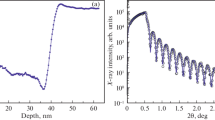Abstract
Oxidation kinetics of microwave plasma assisted CVD diamond and diamond-like carbon (DLC) films in flowing oxygen were evaluated in the temperature range of 500 to 750 °C and were compared with those of graphite and natural diamond. The diamond and DLC films were prepared using CH4/H2 ratios of 0.1, 0.25, 0.5, 1.0, and 2.0%. The films deposited at 0.1% ratio had a faceted crystalline structure with high sp3 content and as the ratio increased toward 2%, the films contained more and more fine crystalline sp2 bonded carbon. The oxidation rates were determined by thermal gravimetric analysis (TGA), which shows that the films deposited at ratios of 2, 1, and 0.5% oxidized at high rates and lie between the rates of natural diamond and graphite. The oxidation rate decreased with lower CH4/H2 ratio and the films deposited at 0.25 and 0.1% exhibited the lowest oxidation rates associated with the highest activation energies in the range of 293-285 kJ/mol • K. The oxidation behavior of microwave plasma assisted diamond films was similar to that of DC plasma assisted CVD diamond films. The results suggest that the same mechanism of oxidation is operational in both DC and microwave plasma assisted diamond films and is probably related to the microstructure and preferred orientation of the crystallites.
Similar content being viewed by others
References
B.V. Spitsyn, L. L. Bouilov, and B.V. Derjaguin, J. Cryst. Growth 52, 219 (1981).
A. Ono, T. Baba, H. Funamoto, and A. Nishikawa, Jpn. J. Appl. Phys. 25, L808 (1986).
M. Kamo, Y. Sato, S. Matsumoto, and N. Setaka, J. Cryst. Growth 62, 642 (1983).
A. Sawabe and T. Inuzuka, Thin Solid Films 137, 89 (1986).
K. Kitahama, K. Hirata, H. Nakamatsu, S. Kawai, N. Fujimori, T. Imai, H. Yoshino, and A. Doi, Appi. Phys. Lett. 49, 634 (1986).
W. L. Hsu, D. M. Tung, E. A. Fuchs, K. F. McCarty, A. Joshi, and R. Nimmagadda, Appl. Phys. Lett. 55 (26), 2739 (1989).
Properties of Diamond, edited by J. E. Field (Academic Press, New York, 1979).
T. Evans and C. Phaal, Proc. 5th Biennial Conference on Carbon, The Pennsylvania State University, University Park, PA, 147–153 (1962).
A. Joshi, R. Nimmagadda, and J. Herrington, J. Vac. Sci. Tech. A8, 2137 (1990).
D. M. Tung, W. L. Hsu, and K. F. McCarty, Proc. 1st Int. Symp. on Diamond and Diamond-like Films, 175th Electrochemical Society Meeting, 500 (1989).
D. S. Knight and W. B. White, J. Mater. Res. 4, 385 (1989).
Author information
Authors and Affiliations
Additional information
@@
Rights and permissions
About this article
Cite this article
Nimmagadda, R.R., Joshi, A. & Hsu, W.L. Role of microstructure on the oxidation behavior of microwave plasma synthesized diamond and diamond-like carbon films. Journal of Materials Research 5, 2445–2450 (1990). https://doi.org/10.1557/JMR.1990.2445
Received:
Accepted:
Published:
Issue Date:
DOI: https://doi.org/10.1557/JMR.1990.2445




